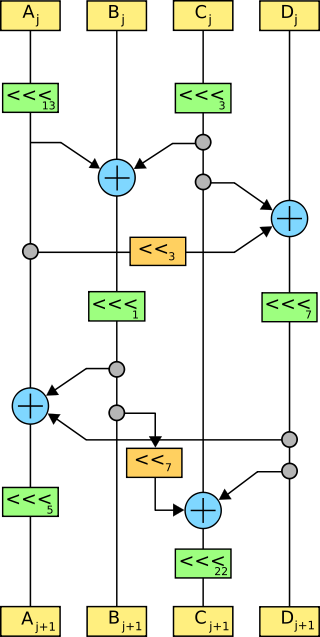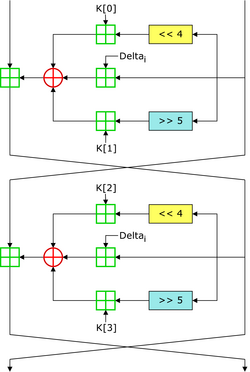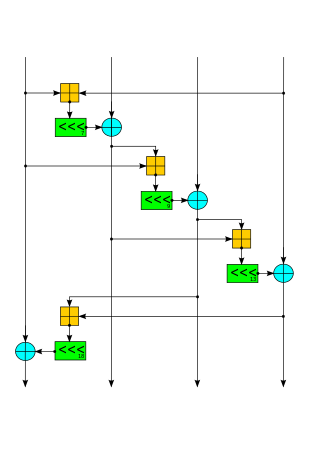Related Research Articles

The Advanced Encryption Standard (AES), also known by its original name Rijndael, is a specification for the encryption of electronic data established by the U.S. National Institute of Standards and Technology (NIST) in 2001.
Blowfish is a symmetric-key block cipher, designed in 1993 by Bruce Schneier and included in many cipher suites and encryption products. Blowfish provides a good encryption rate in software, and no effective cryptanalysis of it has been found to date. However, the Advanced Encryption Standard (AES) now receives more attention, and Schneier recommends Twofish for modern applications.
In cryptography, a block cipher is a deterministic algorithm that operates on fixed-length groups of bits, called blocks. Block ciphers are the elementary building blocks of many cryptographic protocols. They are ubiquitous in the storage and exchange of data, where such data is secured and authenticated via encryption.

In cryptography, a cipher is an algorithm for performing encryption or decryption—a series of well-defined steps that can be followed as a procedure. An alternative, less common term is encipherment. To encipher or encode is to convert information into cipher or code. In common parlance, "cipher" is synonymous with "code", as they are both a set of steps that encrypt a message; however, the concepts are distinct in cryptography, especially classical cryptography.

In cryptography, RC5 is a symmetric-key block cipher notable for its simplicity. Designed by Ronald Rivest in 1994, RC stands for "Rivest Cipher", or alternatively, "Ron's Code". The Advanced Encryption Standard (AES) candidate RC6 was based on RC5.

In cryptography, a block cipher mode of operation is an algorithm that uses a block cipher to provide information security such as confidentiality or authenticity. A block cipher by itself is only suitable for the secure cryptographic transformation of one fixed-length group of bits called a block. A mode of operation describes how to repeatedly apply a cipher's single-block operation to securely transform amounts of data larger than a block.

Serpent is a symmetric key block cipher that was a finalist in the Advanced Encryption Standard (AES) contest, in which it ranked second to Rijndael. Serpent was designed by Ross Anderson, Eli Biham, and Lars Knudsen.

In cryptography, the Tiny Encryption Algorithm (TEA) is a block cipher notable for its simplicity of description and implementation, typically a few lines of code. It was designed by David Wheeler and Roger Needham of the Cambridge Computer Laboratory; it was first presented at the Fast Software Encryption workshop in Leuven in 1994, and first published in the proceedings of that workshop.

In cryptography, XTEA is a block cipher designed to correct weaknesses in TEA. The cipher's designers were David Wheeler and Roger Needham of the Cambridge Computer Laboratory, and the algorithm was presented in an unpublished technical report in 1997. It is not subject to any patents.
CCM mode is a mode of operation for cryptographic block ciphers. It is an authenticated encryption algorithm designed to provide both authentication and confidentiality. CCM mode is only defined for block ciphers with a block length of 128 bits.

Salsa20 and the closely related ChaCha are stream ciphers developed by Daniel J. Bernstein. Salsa20, the original cipher, was designed in 2005, then later submitted to the eSTREAM European Union cryptographic validation process by Bernstein. ChaCha is a modification of Salsa20 published in 2008. It uses a new round function that increases diffusion and increases performance on some architectures.

ShāngMì 4 is a block cipher used in the Chinese National Standard for Wireless LAN WAPI and also used with Transport Layer Security.
In cryptography, Galois/Counter Mode (GCM) is a mode of operation for symmetric-key cryptographic block ciphers which is widely adopted for its performance. GCM throughput rates for state-of-the-art, high-speed communication channels can be achieved with inexpensive hardware resources.
In cryptography, FEA-M is a block cipher developed in 2001 by X. Yi, C. H. Tan, C. K. Siew, and M. R. Syed.
In cryptography, Treyfer is a block cipher/MAC designed in 1997 by Gideon Yuval. Aimed at smart card applications, the algorithm is extremely simple and compact; it can be implemented in just 29 bytes of 8051 machine code.
In cryptography, M8 is a block cipher designed by Hitachi in 1999. It is a modification of Hitachi's earlier M6 algorithm, designed for greater security and high performance in both hardware and 32-bit software implementations. M8 was registered by Hitachi in March 1999 as ISO/IEC 9979-0020.

Threefish is a symmetric-key tweakable block cipher designed as part of the Skein hash function, an entry in the NIST hash function competition. Threefish uses no S-boxes or other table lookups in order to avoid cache timing attacks; its nonlinearity comes from alternating additions with exclusive ORs. In that respect, it is similar to Salsa20, TEA, and the SHA-3 candidates CubeHash and BLAKE.
In cryptography, format-preserving encryption (FPE), refers to encrypting in such a way that the output is in the same format as the input. The meaning of "format" varies. Typically only finite sets of characters are used; numeric, alphabetic or alphanumeric. For example:
The following outline is provided as an overview of and topical guide to cryptography:

Speck is a family of lightweight block ciphers publicly released by the National Security Agency (NSA) in June 2013. Speck has been optimized for performance in software implementations, while its sister algorithm, Simon, has been optimized for hardware implementations. Speck is an add–rotate–xor (ARX) cipher.
References
- ↑ "Red Pike cipher", Red Pike cipher, Cypherpunk mailing list, Gmane
- C Mitchell, S Murphy, F Piper, P Wild. (1996). Red Pike — an assessment. Codes and Ciphers Ltd 2/10/96.
- Paper by Anderson and Kuhn which includes excerpts from (Mitchell et al., 1996). Another version is Anderson, Ross; Kuhn, Markus (1997). "Low Cost Attacks on Tamper Resistant Devices" (PDF). Security Protocols, 5th International Workshop. pp. 125–136.
- "The use of encryption and related services with the NHSnet"